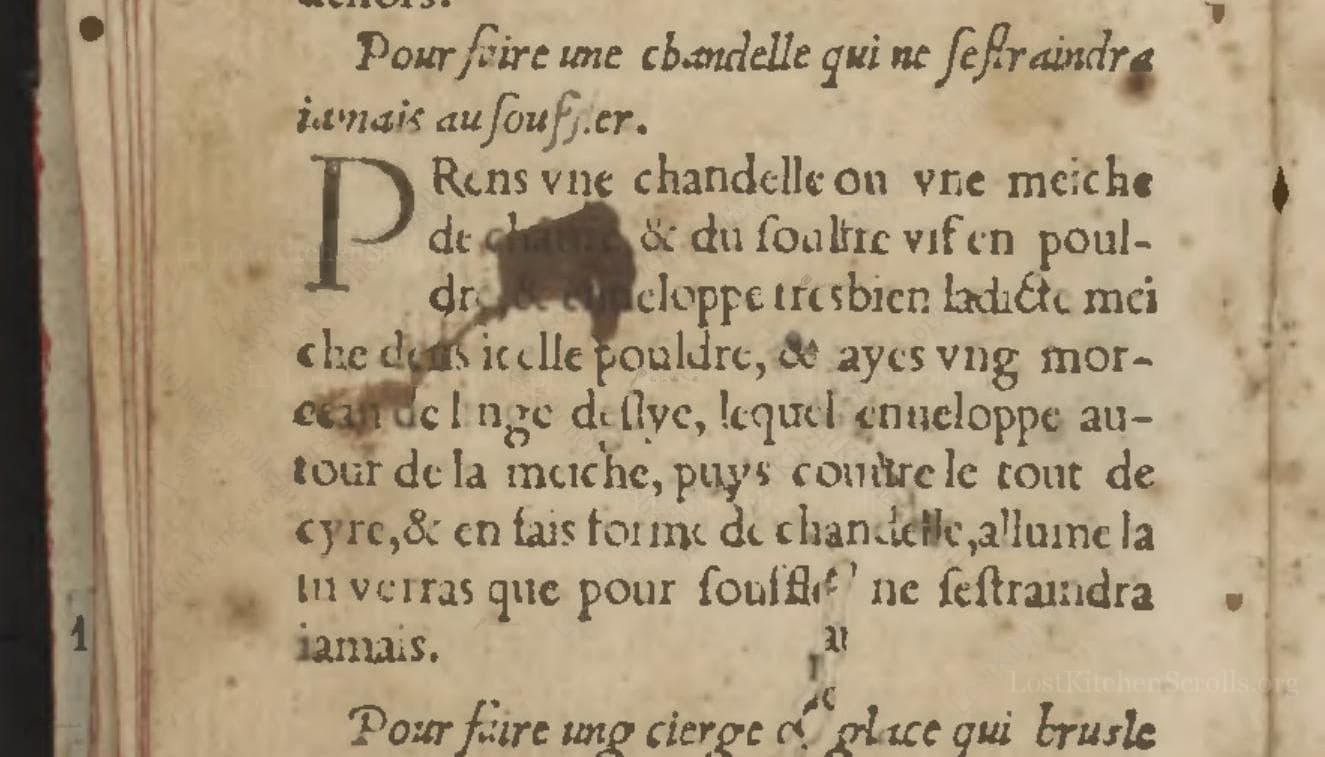Pour Faire Vne Chandelle Qui Ne Sestraindra Iamais Au Fouffler
"To Make A Candle That Will Never Be Extinguished By Blowing"
From the treasured pages of Bastiment de receptes
Unknown Author

Pour Faire Vne Chandelle Qui Ne Sestraindra Iamais Au Fouffler
"Prens vne chandelle ou vne meiche de chanvre & du soufre vif en pouldre, & envelloppe tresbien ladicte meiche dens icelle pouldre, & ayes vng morceau de linge delye, lequel envelloppe autour de la meiche, puys couvre le tout de cyre, & en fais forme de chandelle, allume la tu verras que pour fouffler ne sestraindra iamais."
English Translation
"To make a candle that will never be extinguished by blowing. Take a candle or a hemp wick and some brimstone (sulfur) in powder, and wrap the said wick very well in this powder. Also, have a piece of fine cloth, which you wrap around the wick, then cover everything with wax and shape it into a candle. Light it and you will see that no matter how much you blow, it will never be extinguished."
Note on the Original Text
The recipe is written in Middle French, with archaic spellings (e.g. 'sestraindra' for 's'éteindra'—meaning 'will not go out') and a direct, no-frills style. The instructions assume the reader is familiar with the handling of raw materials like sulfur and beeswax. The text cautions the maker in veiled terms—sulfur was known to have pungent fumes and was used both for magic and practical jokes. The playful, semi-mystical tone was popular in 'books of secrets,' appealing to both curiosity and household utility.

Title
Bastiment de receptes (1541)
You can also click the book image above to peruse the original tome
Writer
Unknown
Era
1541
Publisher
A Lescu de Coloigne
Background
Step into the culinary secrets of Renaissance France! 'Bastiment de receptes' is a delectable compendium newly translated from Italian, brimming with recipes, curious odors, and medicinal tidbits designed to both delight the palate and preserve health.
Kindly made available by
Library of Congress
This recipe comes from the mid-16th century French book 'Bastiment de receptes,' published in Lyon in 1541 by the Frellon printers. At that time, 'books of secrets' offered practical household recipes, from perfumes to medicines, to all manner of curious tricks. This particular recipe fell into the realm of experimental 'fire tricks': a magical candle seemingly unextinguishable by ordinary breath, delighting and startling the audience of the Renaissance home.

In the 16th century, this recipe would have been made using basic household tools—a mortar and pestle to powder the sulfur, linen scraps cut with shears, a small pot or pan to melt beeswax over a hearth, tongs to handle the hot materials, and perhaps a simple form or hands to shape the candle. Work would be done by the kitchen fire or a workshop table.
Prep Time
10 mins
Cook Time
30 mins
Servings
1
We've done our best to adapt this historical recipe for modern kitchens, but some details may still need refinement. We warmly welcome feedback from fellow cooks and culinary historians — your insights support the entire community!
Ingredients
- 1 candle wick (6 inches, hemp or cotton)
- 0.35 oz powdered sulfur (sulfur flowers, available as garden sulfur)
- 1 piece of fine linen (about 6x2 inches)
- 1.75-2.5 oz beeswax
Instructions
- To make a candle that will never go out, start by taking a standard candle wick made of hemp or cotton, approximately 6 inches long.
- Coat the wick thoroughly in powdered sulfur (about 0.35 ounces should suffice for one candle).
- Then wrap this powdered wick tightly in a thin linen cloth so it forms a neat bundle.
- Melt approximately 1.75-2.5 ounces of beeswax and cover the wrapped wick completely, shaping the whole into a typical candle form.
- Allow the wax to set.
- Once ready, light the candle—the recipe promises no amount of blowing will extinguish it (though, please note, the candle will emit strong fumes and should only be lit outdoors or in a well-ventilated area).
Cooking Estimates
You will spend a few minutes preparing the wick and wrapping it in linen, then melting and pouring the beeswax. The wax will need time to cool and set before your candle is ready. This recipe makes one special candle and is not intended for eating, so there are no calories.
As noted above, we have made our best effort to translate and adapt this historical recipe for modern kitchens, taking into account ingredients nowadays, cooking techniques, measurements, and so on. However, historical recipes often contain assumptions that require interpretation.
We'd love for anyone to help improve these adaptations. Community contributions are highly welcome. If you have suggestions, corrections, or cooking tips based on your experience with this recipe, please share them below.
Join the Discussion
Rate This Recipe

Den Bockfisch In Einer Fleisch Suppen Zu Kochen
This recipe hails from a German manuscript cookbook compiled in 1696, a time whe...

Die Grieß Nudlen Zumachen
This recipe comes from a rather mysterious manuscript cookbook, penned anonymous...

Ein Boudain
This recipe comes from an anonymous German-language manuscript cookbook from 169...

Ein Gesaltzen Citroni
This recipe, dating from 1696, comes from an extensive anonymous German cookbook...
Browse our complete collection of time-honored recipes



